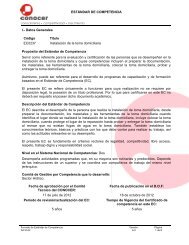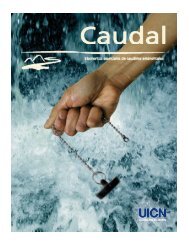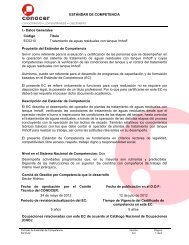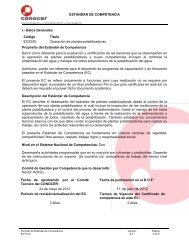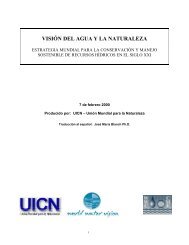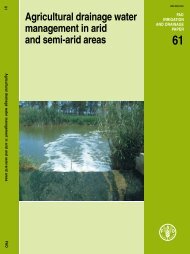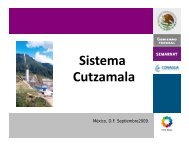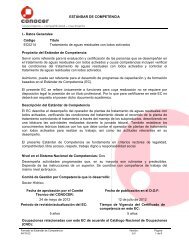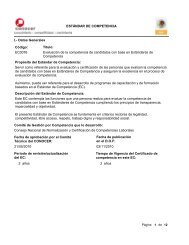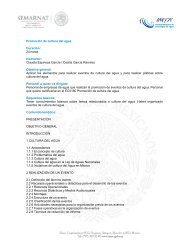An Assessment of the Status of Biodiversity in the Muthurajawela ...
An Assessment of the Status of Biodiversity in the Muthurajawela ...
An Assessment of the Status of Biodiversity in the Muthurajawela ...
You also want an ePaper? Increase the reach of your titles
YUMPU automatically turns print PDFs into web optimized ePapers that Google loves.
4. Fauna <strong>of</strong> <strong>Muthurajawela</strong><br />
Species composition and relative abundance <strong>of</strong> vertebrate fauna<br />
A total <strong>of</strong> 209 species <strong>of</strong> vertebrate fauna, belong<strong>in</strong>g to 96 families were recorded from<br />
<strong>Muthurajawela</strong>. Of <strong>the</strong> total number <strong>of</strong> species recorded, 17 (9 %) are endemic, while 26 (12<br />
%) are nationally threatened (IUCN Sri Lanka, 2000). Among <strong>the</strong> endemic vertebrate species<br />
at <strong>Muthurajawela</strong>, 60% are nationally threatened. A comparison <strong>of</strong> <strong>in</strong>land native vertebrate<br />
fauna <strong>of</strong> Sri Lanka and <strong>in</strong> <strong>the</strong> <strong>Muthurajawela</strong> wetland sanctuary is shown <strong>in</strong> Figure 4. The<br />
native vertebrate fauna <strong>of</strong> <strong>Muthurajawela</strong> represents 30% <strong>of</strong> Sri Lanka’s native <strong>in</strong>land<br />
vertebrate species. This is a significant proportion, when consider<strong>in</strong>g <strong>the</strong> size <strong>of</strong> this wetland.<br />
Of <strong>the</strong> total vertebrate species recorded, a majority (35%) were uncommon, while 13% were<br />
very common, and 5% were very rare.<br />
Sri Lanka<br />
<strong>Muthurajawela</strong><br />
226<br />
155<br />
78<br />
83<br />
90<br />
54<br />
35<br />
14<br />
31<br />
22<br />
Fish Amphibians Reptiles Birds Mammals<br />
Group<br />
Figure 4<br />
Comparison <strong>of</strong> <strong>in</strong>land native vertebrate species <strong>of</strong> Sri Lanka with those <strong>in</strong> <strong>the</strong> <strong>Muthurajawela</strong> wetland.<br />
The fish consisted <strong>of</strong> 40 species (5 endemics) belong<strong>in</strong>g to 23 families (Appendix 4),<br />
represent<strong>in</strong>g approximately 45% <strong>of</strong> Sri Lanka’s native <strong>in</strong>land fishes. Among <strong>the</strong>m, 5 species<br />
are nationally threatened, while 4 are exotic. These were distributed <strong>in</strong> lentic (ie., ponds,<br />
marshes) and lotic (ie., canals, streams, rivers) habitats, as well as <strong>the</strong> transition area <strong>of</strong> <strong>the</strong><br />
marsh-lagoon complex, which is subjected to daily tidal <strong>in</strong>fluence. The Tilapia (Saro<strong>the</strong>rodon<br />
mossambicus), Pearl Spot (Etroplus suratensis) and <strong>the</strong> Dwarf Panchax (Aplocheilus parvus)<br />
were very common species <strong>of</strong> fish at <strong>Muthurajawela</strong>. The fish also <strong>in</strong>cluded freshwater and<br />
mar<strong>in</strong>e migratory species, which were ma<strong>in</strong>ly observed <strong>in</strong> <strong>the</strong> Dandugam Oya and <strong>the</strong> marshlagoon<br />
transition zone. For <strong>in</strong>stance, <strong>the</strong> “catadromous” species (Species that migrate from<br />
12



